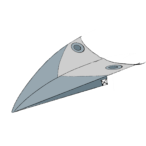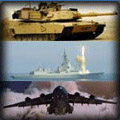B-2 can now drop the B61-12 nuclear bomb using the new Radar Aided Targeting System (RATS)
A B-2A Spirit stealth bomber released a B61-12 Joint Test Assembly (JTA) utilizing a new capability known as Radar Aided Targeting System (RATS) during a capstone test...
Tested only on the B-2, RATS improves weapon guidance accuracy in a Global Positioning System-degraded environment.
A software tool designed in-house by the 72d TES (Test and Evaluation Squadron) known as the RATS Application Tool, it provides pilots an early indicator of the RATS’ functionality, verifying that the system is operating correctly prior to weapon release.
https://www.whiteman.af.mil/News/Articl ... tone-test/
https://alert5.com/2022/07/09/b-2-can-n ... ng-system/
Fuerza Aérea de EE.UU. (USAF)
Moderadores: Lepanto, poliorcetes, Edu, Orel
Re: Fuerza Aérea de EE.UU. (USAF)
Escucha también el Podcast:
https://www.youtube.com/channel/UCuBzQorV74eTFq8HlK7-zRA
https://www.ivoox.com/podcast-portierramaryaire-podcast_sq_f1456223_1.html
Y tenemos un Patreon:
https://www.patreon.com/portierramaryaire
https://www.youtube.com/channel/UCuBzQorV74eTFq8HlK7-zRA
https://www.ivoox.com/podcast-portierramaryaire-podcast_sq_f1456223_1.html
Y tenemos un Patreon:
https://www.patreon.com/portierramaryaire
-

Orel - Moderador
- Mensajes: 46184
- Registrado: Sab Sep 24, 2005 11:33 am
- Ubicación: España, en el bocho
Re: Fuerza Aérea de EE.UU. (USAF)
Quieren pistolas de "Air Soft" Sig Sauer M18 para la "Officer Training School" de la BA de Maxwell: https://sam.gov/opp/40d0edbc36e54b1497a ... c6d5b/view


- champi
- Moderador
- Mensajes: 13626
- Registrado: Vie Nov 21, 2008 10:53 pm
Re: Fuerza Aérea de EE.UU. (USAF)
Parece que la USAF desecha la idea de un B-21 sin piloto: https://breakingdefense.com/2022/07/exc ... n-concept/
En plataformas grandes el ahorro apenas se nota.
En plataformas grandes el ahorro apenas se nota.
- champi
- Moderador
- Mensajes: 13626
- Registrado: Vie Nov 21, 2008 10:53 pm
Re: Fuerza Aérea de EE.UU. (USAF)
Es que si ya lo has hecho con todo el equipamiento para poder ser tripulado, y además los pilotos necesitan volar para tener sus certificaciones, casi no te renta la ganancia de volarlo solo.
Escucha también el Podcast:
https://www.youtube.com/channel/UCuBzQorV74eTFq8HlK7-zRA
https://www.ivoox.com/podcast-portierramaryaire-podcast_sq_f1456223_1.html
Y tenemos un Patreon:
https://www.patreon.com/portierramaryaire
https://www.youtube.com/channel/UCuBzQorV74eTFq8HlK7-zRA
https://www.ivoox.com/podcast-portierramaryaire-podcast_sq_f1456223_1.html
Y tenemos un Patreon:
https://www.patreon.com/portierramaryaire
-

Orel - Moderador
- Mensajes: 46184
- Registrado: Sab Sep 24, 2005 11:33 am
- Ubicación: España, en el bocho
Re: Fuerza Aérea de EE.UU. (USAF)
La USAF se plantea la posibilidad de envío de cazas antiguos a Ucrania como los A-10, lo dudo mucho pero ahí va:
https://www.infodefensa.com/texto-diari ... cluidos-10
https://www.infodefensa.com/texto-diari ... cluidos-10
Escucha también el Podcast:
https://www.youtube.com/channel/UCuBzQorV74eTFq8HlK7-zRA
https://www.ivoox.com/podcast-portierramaryaire-podcast_sq_f1456223_1.html
Y tenemos un Patreon:
https://www.patreon.com/portierramaryaire
https://www.youtube.com/channel/UCuBzQorV74eTFq8HlK7-zRA
https://www.ivoox.com/podcast-portierramaryaire-podcast_sq_f1456223_1.html
Y tenemos un Patreon:
https://www.patreon.com/portierramaryaire
-

Orel - Moderador
- Mensajes: 46184
- Registrado: Sab Sep 24, 2005 11:33 am
- Ubicación: España, en el bocho
Re: Fuerza Aérea de EE.UU. (USAF)
Orel escribió:La USAF se plantea la posibilidad de envío de cazas antiguos a Ucrania como los A-10, lo dudo mucho pero ahí va:
https://www.infodefensa.com/texto-diari ... cluidos-10
No lo dudes, la USAF lleva años queriendo quitarselos de encima...ahora o nunca.
Calmatum et Tranquilitis
Hunde en la miseria o indulta a tus terrores aeroprimigenios favoritos en: ESPANTOS AERONAUTICOS
Hunde en la miseria o indulta a tus terrores aeroprimigenios favoritos en: ESPANTOS AERONAUTICOS
-

Truquichan - Mensajes: 2204
- Registrado: Vie Jun 25, 2021 9:21 am
Re: Fuerza Aérea de EE.UU. (USAF)
De hecho, si no recuerdo mal la USAF queria empezar a darlos de baja / transferirlos a la guardia nacional, y el congreso no lo aprovo y ordeno que siguieran al frente.
Enviado desde mi Nespresso con RistrettoTalk 0.59.1.31415.27alpha
-

Lazarus - Mensajes: 1988
- Registrado: Jue Abr 28, 2022 1:32 pm
Re: Fuerza Aérea de EE.UU. (USAF)
Parece que el B21 viene y además con grata sorpresa. El coste de desarrollo del bombardero estimado en unos 25 billones de dólares, estará bien por debajo.
B-21 Bomber Delivers Pentagon Surprise: It’s Under Budget So Far
https://www.bloomberg.com/news/articles ... #xj4y7vzkg
B-21 Bomber Delivers Pentagon Surprise: It’s Under Budget So Far
https://www.bloomberg.com/news/articles ... #xj4y7vzkg
-

Pathfinder - Mensajes: 3079
- Registrado: Jue Jul 27, 2017 9:44 pm
Re: Fuerza Aérea de EE.UU. (USAF)
25 billones americanos, que si no a alguno lo da un patatús. Unos 25.000 millones de dólares.
-

Augur - Mensajes: 1217
- Registrado: Vie Ago 28, 2020 6:06 pm
Re: Fuerza Aérea de EE.UU. (USAF)
Augur escribió:25 billones americanos, que si no a alguno lo da un patatús. Unos 25.000 millones de dólares.
Casi casi nuesto presupuesto de defensa de dos años. Patatus nos va a dar igual
Enviado desde mi Nespresso con RistrettoTalk 0.59.1.31415.27alpha
-

Lazarus - Mensajes: 1988
- Registrado: Jue Abr 28, 2022 1:32 pm
Re: Fuerza Aérea de EE.UU. (USAF)
B-2 stealth bomber successfully launches long-range cruise missile JAASM-ER
26 August 2022
The reveal comes from B-2 maker Northrop Grumman, which says the US Air Force successfully tested air launching the extended range variant of a low-observable cruise missile in December 2021.
https://www.flightglobal.com/fixed-wing ... 91.article
USAF B-2 bombers conclude first Australia deployment:
https://twitter.com/JanesINTEL/status/1 ... GZqq8rAAAA

https://pbs.twimg.com/media/Fa9UY5rWYAA ... =4096x4096
USAFE ‘excited' to learn SwAF [fuerza aérea sueca] aircraft dispersal techniques
https://twitter.com/JanesINTEL/status/1 ... iT_rgrAAAA
26 August 2022
The reveal comes from B-2 maker Northrop Grumman, which says the US Air Force successfully tested air launching the extended range variant of a low-observable cruise missile in December 2021.
https://www.flightglobal.com/fixed-wing ... 91.article
USAF B-2 bombers conclude first Australia deployment:
https://twitter.com/JanesINTEL/status/1 ... GZqq8rAAAA

https://pbs.twimg.com/media/Fa9UY5rWYAA ... =4096x4096
USAFE ‘excited' to learn SwAF [fuerza aérea sueca] aircraft dispersal techniques
https://twitter.com/JanesINTEL/status/1 ... iT_rgrAAAA
Escucha también el Podcast:
https://www.youtube.com/channel/UCuBzQorV74eTFq8HlK7-zRA
https://www.ivoox.com/podcast-portierramaryaire-podcast_sq_f1456223_1.html
Y tenemos un Patreon:
https://www.patreon.com/portierramaryaire
https://www.youtube.com/channel/UCuBzQorV74eTFq8HlK7-zRA
https://www.ivoox.com/podcast-portierramaryaire-podcast_sq_f1456223_1.html
Y tenemos un Patreon:
https://www.patreon.com/portierramaryaire
-

Orel - Moderador
- Mensajes: 46184
- Registrado: Sab Sep 24, 2005 11:33 am
- Ubicación: España, en el bocho
Re: Fuerza Aérea de EE.UU. (USAF)
ACC Federal Laboratory flies combat apps on F-22 with new open software stack
Aug. 31, 2022
Members of the Air Combat Command Federal Laboratory, test pilots at Edwards Air Force Base, and software developers from the 309th Software Engineering Group achieved several milestones on an in-flight F-22 Raptor, Aug. 24.
The achievement is the first instance of third-party software running on a fifth-generation fighter and the first in-flight use of open-source container orchestration software on any fighter aircraft.
Fifth-generation fighter aircraft are historically unavailable to third-party software integration. To fix this problem and lower the barriers to entry, the team built and flight-tested their new Open Systems Enclave, or OSE, consisting of a government-owned software architecture with existing on-board hardware. This new enclave proved it can rapidly integrate new technologies from first line of code to flight in less than 60 days. In recognition of this value proposition, there is now a formal requirement for the establishment of OSE on F-22 at the direction of the chief of F-22 requirements.
“This breakthrough fundamentally changes how we can deliver combat capability to the warfighter,” said Maj. Allen Black, F-22 test pilot and project co-lead. “We’ve proven the ability to rapidly evaluate and integrate next-generation technologies developed by experts in government, industry, and academia at a lower cost with software portability across defense platforms.”
Established in 2018, the ACC Federal Laboratory functions under the Office of the Chief Scientist and operates with a vision to summon and coalesce a “Confluence of Warfighters, Developers, and Acquirers” while bridging advanced technologies with fielded weapon systems. The result is an inspired defense industrial base with intellectual property protection and increased safeguards to mission critical systems.
This confluence model quickly proved its worth in 2020 by achieving a Defense Department first in artificial intelligence when human-AI teaming was flown with an AI copilot, “Artuµ.”
The lab changed public policy in 2021 and established the National Institute for Standards and Technology’s 20th Laboratory Accreditation Program known as Federal Warfare Systems. NIST accreditation standardizes the competence, impartiality, and operational consistency of Federal Laboratories of this type in the DoD, providing senior leaders with published policy to sanction and underwrite this activity.
The ACC Federal Laboratory is uniquely positioned to leverage the space left of formal requirements, where technologies vital to all air power systems can be matured, verified and validated in comparable technical and operational environments.
“The complimentary position of the ACC Fed Lab. within the acquisitions process allows the government to fly before they buy,” said Maj. Ray Tierney, ACC Federal Laboratory founder and director. “This increases modernization throughput, decouples software development from Operational Flight Program cycles, and allows the delivery of advanced capability to assure dominance in strategically competitive environments – creating cost offsets previously believed to be impossible.”
As a Total Force Integration entity, the ACC Federal Laboratory is comprised of active duty, Guard, Reserve, civilian and contractor personnel. “We have had overwhelming interest from government, industry, and academic partners to make our platforms more capable – and more lethal,” said Lt. Col. Raven LeClair, test pilot and project co-lead. “Most notable, however, has been the reciprocated interest by warfighters within the Air Force, Air Force Reserve, Air National Guard, as well as U.S. Space Force and U.S. Navy.”
Ultimately, this milestone shines a bright future for software acquisition in the DoD, one where apps are rapidly developed, matured and delivered to the warfighter at the push of a button. Initially working with F-22 Program Office as an early adopter of OSE, the team is evaluating and integrating several candidate combat capabilities as cross-platform solutions.
“We must build an enduring advantage for our force,” said Gen. Mark Kelly, commander of Air Combat Command. “This ‘bring the future faster’ initiative allows us to rapidly discover and iterate on combat capabilities and stay relevant with cutting-edge technology and affordably accelerate change in delivering combat Air Force capabilities as an enterprise.”
https://www.af.mil/News/Article-Display ... are-stack/
Escucha también el Podcast:
https://www.youtube.com/channel/UCuBzQorV74eTFq8HlK7-zRA
https://www.ivoox.com/podcast-portierramaryaire-podcast_sq_f1456223_1.html
Y tenemos un Patreon:
https://www.patreon.com/portierramaryaire
https://www.youtube.com/channel/UCuBzQorV74eTFq8HlK7-zRA
https://www.ivoox.com/podcast-portierramaryaire-podcast_sq_f1456223_1.html
Y tenemos un Patreon:
https://www.patreon.com/portierramaryaire
-

Orel - Moderador
- Mensajes: 46184
- Registrado: Sab Sep 24, 2005 11:33 am
- Ubicación: España, en el bocho
Re: Fuerza Aérea de EE.UU. (USAF)
Es del Pentágono sobre todas las FAS yanquis, pero lo pongo aquí:
Citing lengthy aircraft development timelines, Pentagon pushes for faster technology rollout
2 September 2022
The US military takes too long to develop new technologies and turn them into effective battlefield platforms.
That is the assessment of Deputy Secretary of Defense Kathleen Hicks, who on 31 August stressed the need for the US military to accelerate the pace at which it develops and fields technological advancements.
“Simply put, we don’t have decades to wait for the latest and greatest concepts and capabilities to proliferate across our military forces,” says Hicks, speaking at a Defense Advanced Research Projects Agency (DARPA) conference in Colorado.
As an example, she cites the rollout of stealth technology for the Department of Defense (DoD) fleet of combat aircraft, which spans the USA’s air force, navy and marine corps.
“When DARPA initiated the project that led to the first experimental stealth aircraft – Have Blue – to when DoD fielded an operational F-117 Nighthawk… took nearly a decade,” Hicks notes. It was the world’s first operational stealth aircraft... Hicks notes that even after the F-117’s success, “it took another decade for stealth technology to be incorporated into an operational B-2 bomber”.
Then, it took “another decade or two” for stealth to be “mainstreamed” across much of the Pentagon’s combat-aircraft fleet, in the form of the F-22 and the F-35. The sprawling F-35 Joint Strike Fighter project was beset by numerous delays and cost overruns. It is projected to be the most-expensive weapons development programme in history.
“Perhaps that timeline was tolerable in the Cold War, when our main strategic competitor was relatively lumbering and slow,” but not in today’s fast-paced, technologically changing world, Hicks says.
The push for more-rapid development and fielding of new systems has become a DoD-wide initiative, with particular focus on software that powers complex weapon systems like modern aircraft.
Known within the Pentagon asmodular open-systems approach (MOSA), the strategy will require future procurement programmes be built on open-source software. The goal is to allow third-party developers to quickly and cheaply create new sensors, weapons and other applications for existing platforms.
The US Air Force recently tested the first third party-derived software on a fifth-generation aircraft, and the US Army made MOSA a requirement for its Future Vertical Lift (FVL) initiative.
Major General Walter Rugen, head of FVL, recently emphasised the importance of MOSA: “What you’re seeing… with MOSA is this flexibility to bring whatever the commander needs and tailor it,” Rugen said on 23 August at the Center for Strategic and International Studies in Washington DC.
He and other military leaders say rapidly developing new applications to meet battlefield needs in potential conflicts could give US forces a substantial leg up.
While MOSA has been incorporated into FVL designs, the concept has produced concern in the defence industrial sector. Previously, after a design was selected and contracts awarded, the original manufacturer would hold an effective monopoly on sustainment and subsequent modernisation, which were dependent on proprietary software. The open-source approach potentially undermines that, threatening future revenue streams. Rugen acknowledges that concern, in an industry with inherently massive up-front costs, but argues the shift is essential to reign in programme costs and ensure battlefield flexibility.
But FVL is not necessarily a shining example of the rapid development Hicks seeks. Between development, competitive testing, production and eventual fielding, timelines for the Future Long Range Assault Aircraft (FLRAA) replacement for the UH-60 Black Hawk and the Future Attack Reconnaissance Aircraft (FARA) successor to the OH-58 Kiowa scout resemble the multi-decade scale from which Hicks wishes to escape. FARA and FLRAA are the two programmes under FVL.
Hicks urges shorter procurement timelines.
“We have to evolve faster than the threats evolve, which means our capabilities must be designed and built to be flexible, adaptable and interoperable from the beginning,” she argues. “We must keep building and growing our enduring advantage?”
https://www.flightglobal.com/fixed-wing ... 67.article
Escucha también el Podcast:
https://www.youtube.com/channel/UCuBzQorV74eTFq8HlK7-zRA
https://www.ivoox.com/podcast-portierramaryaire-podcast_sq_f1456223_1.html
Y tenemos un Patreon:
https://www.patreon.com/portierramaryaire
https://www.youtube.com/channel/UCuBzQorV74eTFq8HlK7-zRA
https://www.ivoox.com/podcast-portierramaryaire-podcast_sq_f1456223_1.html
Y tenemos un Patreon:
https://www.patreon.com/portierramaryaire
-

Orel - Moderador
- Mensajes: 46184
- Registrado: Sab Sep 24, 2005 11:33 am
- Ubicación: España, en el bocho
Re: Fuerza Aérea de EE.UU. (USAF)
Relacionado con lo comentado hace un tiempo de que EEUU está reforzando "aeródromos" en islas remotas:
After a year of construction, Ascension Island Auxiliary Airfield resumed full flight operations recently with the opening of the newly paved eastern portion of the runway.
Construction now transitions to phase three of the project – the western side of the runway – on the remote, British-owned island that supports military missions and commercial flights.
The outpost, located between South America and Africa, is a critical air transport hub for passengers and cargo and the airbridge to the Falkland Islands for Britain’s Royal Air Force missions.
The $309 million project is a jointly funded investment by the U.S. and British governments.
a C-17 Globemaster III was the first aircraft that landed on Ascension’s newly paved runway.
The C-17 is one of the few aircraft in the world able to fly the distance to Ascension and then land and take off on the available runway length.
“Currently, we have to make a fuel stop after takeoff in order to fly back to the states or even to most of Europe, due to the decrease runway length,” he said. “Once it’s increased to its original size you’ll start to see many other types of aircraft landing at Ascension and be able to depart directly to their final destination without needing a fuel stop in between, both saving time and money for everyone involved."
With the eastern half of the runway up and running, demolition of the western half begins in the coming weeks.
https://www.afimsc.af.mil/News/Article- ... abilities/
After a year of construction, Ascension Island Auxiliary Airfield resumed full flight operations recently with the opening of the newly paved eastern portion of the runway.
Construction now transitions to phase three of the project – the western side of the runway – on the remote, British-owned island that supports military missions and commercial flights.
The outpost, located between South America and Africa, is a critical air transport hub for passengers and cargo and the airbridge to the Falkland Islands for Britain’s Royal Air Force missions.
The $309 million project is a jointly funded investment by the U.S. and British governments.
a C-17 Globemaster III was the first aircraft that landed on Ascension’s newly paved runway.
The C-17 is one of the few aircraft in the world able to fly the distance to Ascension and then land and take off on the available runway length.
“Currently, we have to make a fuel stop after takeoff in order to fly back to the states or even to most of Europe, due to the decrease runway length,” he said. “Once it’s increased to its original size you’ll start to see many other types of aircraft landing at Ascension and be able to depart directly to their final destination without needing a fuel stop in between, both saving time and money for everyone involved."
With the eastern half of the runway up and running, demolition of the western half begins in the coming weeks.
https://www.afimsc.af.mil/News/Article- ... abilities/
Escucha también el Podcast:
https://www.youtube.com/channel/UCuBzQorV74eTFq8HlK7-zRA
https://www.ivoox.com/podcast-portierramaryaire-podcast_sq_f1456223_1.html
Y tenemos un Patreon:
https://www.patreon.com/portierramaryaire
https://www.youtube.com/channel/UCuBzQorV74eTFq8HlK7-zRA
https://www.ivoox.com/podcast-portierramaryaire-podcast_sq_f1456223_1.html
Y tenemos un Patreon:
https://www.patreon.com/portierramaryaire
-

Orel - Moderador
- Mensajes: 46184
- Registrado: Sab Sep 24, 2005 11:33 am
- Ubicación: España, en el bocho
Re: Fuerza Aérea de EE.UU. (USAF)
The airpower think tank says the USA’s fleet of combat aircraft is currently smaller, older and less ready than it has been in decades.
https://www.flightglobal.com/fixed-wing ... 67.article
https://www.airforcemag.com/air-force-f ... mployment/
https://www.af.mil/News/Article-Display ... -environm/
https://www.doctrine.af.mil/Portals/61/ ... %20ACE.pdf
Un resumen:
ACE is the method by which the USAF intends to counteract the capabilities of adversaries such as Russia and the People’s Republic of China (PRC)...
Because air power is dependent on airfields, the USAF’s small network of airbases is its greatest weakness in the Asia-Pacific. The USAF has six bases in the region from which to project airpower: Osan and Kunsan Air Bases in the Republic of Korea (ROK); Misawa, Yokota, and Kadena Air Bases in Japan; and Anderson Air Base on Guam. These bases will also function as primary logistical hubs for operations in the early phases of a war.
In the event of a Sino-American war over Taiwan, for example, it is unlikely that Seoul would allow U.S. forces to engage in hostilities with the PRC from bases in the ROK, and Anderson Air Base is approximately 1,700 miles from Taiwan, more than four times the average fighter aircraft’s combat radius. Therefore, the PLA would only have to concentrate strikes on the three airbases in Japan to incapacitate the USAF. Each of those bases—and even Anderson Air Base—is within range of the PLA’s conventional cruise and ballistic missiles.
ACE is an attempt to resolve this predicament principally through dispersed deployment. It involves a network of airfields arranged in “clusters” in which major bases, such as the six bases above, will function as hubs, and a combination of smaller military airfields, civilian airports, and even temporary airstrips will function as spokes. Materiel pre-positioned at these spokes in what are called Regional Base Cluster Pre-positioning (RBCP) kits will ensure that they can independently sustain operations for a period of time. The USAF only intends to disperse units in the early phases of a war—long enough to eliminate the threats to its major bases or at least to absorb the hail of missiles. By presenting many more targets, the USAF should prevent the PLA from achieving significant effects by concentrating strikes on a small number of airbases.
https://jamestown.org/program/the-plas- ... t-concept/
Escucha también el Podcast:
https://www.youtube.com/channel/UCuBzQorV74eTFq8HlK7-zRA
https://www.ivoox.com/podcast-portierramaryaire-podcast_sq_f1456223_1.html
Y tenemos un Patreon:
https://www.patreon.com/portierramaryaire
https://www.youtube.com/channel/UCuBzQorV74eTFq8HlK7-zRA
https://www.ivoox.com/podcast-portierramaryaire-podcast_sq_f1456223_1.html
Y tenemos un Patreon:
https://www.patreon.com/portierramaryaire
-

Orel - Moderador
- Mensajes: 46184
- Registrado: Sab Sep 24, 2005 11:33 am
- Ubicación: España, en el bocho
¿Quién está conectado?
Usuarios navegando por este Foro: No hay usuarios registrados visitando el Foro y 0 invitados
